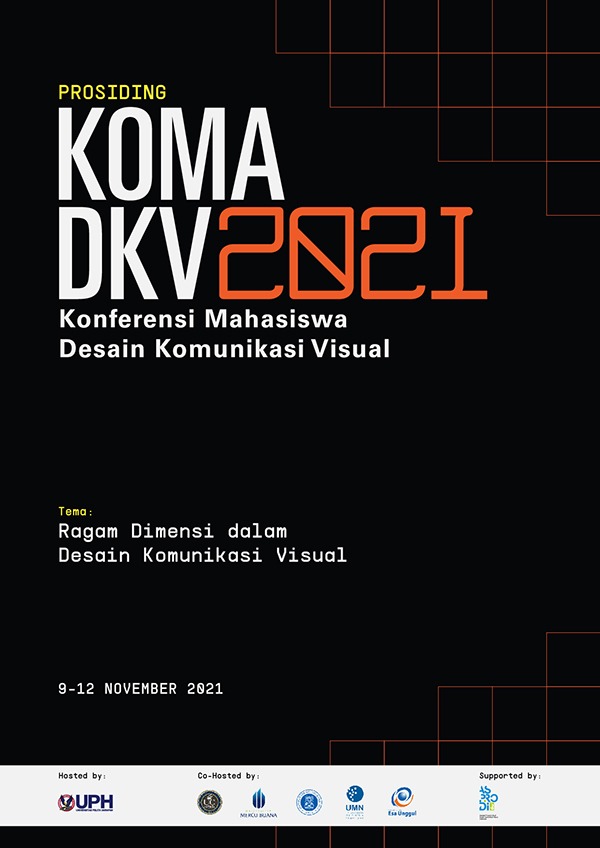Identifikasi Permasalahan Visual Pada Buku Workbook “The Self-Love Workbook For Teens” Oleh Shainna Ali, PhD.
Keywords:
Self-Love, Perancangan Ulang, Workbook, Kesehatan MentalAbstract
Topik terkait kesehatan mental bukan lagi hal yang asing di Indonesia. Walaupun demikian, masih banyak stigma buruk yang beredar akan topik kesehatan mental. Sehingga memperburuk keadaan dan bahkan mengakibatkan ketertutupan akan bantuan dan juga pengobatan terhadap kesehatan mental. Akses terhadap informasi maupun bantuan untuk kesehatan mental, khususnya self-love juga masih relatif rendah dan bersifat kurang lengkap. Journaling merupakan salah satu cara atau alternatif yang dipercayai memiliki manfaat untuk meningkatkan kesehatan mental maupun fisik. Dengan menulis secara ekspresif, kesehatan fisik dan mental dapat meningkat (Pennebaker, 1990, dalam Hussain, 2010, p. 20). Buku workbook/journaling mendorong adanya komponen kejujuran dan vulnerabilitas, dimana komponen tersebut tidak ditemukan dalam buku “The Self-Love Workbook For Teens” oleh Shainna Ali, PhD. Identifikasi permasalahan dilakukan dengan menggunakan Metodologi Desain menurut Robin Landa beserta teori analisa emotional design menurut Don Norman dan teknik analisis SWOT. Pengumpulan data dilakukan melalui studi pustaka dan secondary research yang kemudian dianalisis dengan teknik observasi serta wawancara. Berdasarkan permasalahan visual yang ditemukan, penulis berharap bahwa makalah ini dapat menjadi basis untuk perancangan ulang buku “The Self-Love Workbook For Teens” sebagai alternatif untuk mengatasi permasalahan kesehatan mental, secara spesifik self-love, pada tahap awal.
References
Aftab, M., & Rusli, H. A. (2017). Designing Visceral, Behavioural and Reflective Products. Chinese Journal of Mechanical Engineering (English Edition), 30(5), 1058-1068. https://doi.org/10.1007/s10033-017-0161-x
Ali, D. (2020, February 14). How Self-Love is an act of service with Dr. Shainna Ali [Interview by D.]. Retrieved September 18, 2021, from https://www.doctoryami.com/podcast/85-5
Dewan, P. (2015). Words Versus Pictures: Leveraging the Research on Visual Communication. Partnership: The Canadian Journal of Library and Information Practice and Research, 10(1), 1-10. https://doi.org/10.21083/partnership.v10i1.3137
Dewi, K. S. (2012). BUKU AJAR KESEHATAN MENTAL. UPT UNDIP Press Semarang. http://eprints.undip.ac.id/38840/1/KESEHATAN_MENTAL.pdf
Gürel, E. (2017). SWOT ANALYSIS: A THEORETICAL REVIEW. Journal of International Social Research, 10(51), 994-1006. https://doi.org/10.17719/jisr.2017.1832
Hussain, D. (2010). Healing Through Writing: Insights from Research. International Journal of Mental Health Promotion, 12(2), 19-23. https://doi.org/10.1080/14623730.2010.9721810
Joffe, H. (2008). The power of visual material: Persuasion, emotion and identification. Diogenes, 55(1), 84-93. https://doi.org/10.1177/0392192107087919
Komninos, A. (2020). Norman’s Three Levels of Design. Retrieved September 26, 2021, from https://www.interaction-design.org/literature/article/norman-s-three-levels-of-design
Landa, R. (2011). Graphic Design Solutions (S. A. Poore, Ed.; 4th ed.). Wadsworth/Cengage Learning.
Martin, Bella., & Hanington, B. M. (2012). Universal Methods of Design: 100 Ways To Research Complex Problems, Develop Innovative Ideas, and Design Effective Solutions. Rockport Publishers.
Mental health: strengthening our response. (2018, March 30). World Health Organization. Retrieved September 18, 2021, from https://www.who.int/news-room/fact-sheets/detail/mental-health-strengthening-our-response
Murray, B. (2002, June). Writing to heal. American Psychological Association. Retrieved September 25, 2021, from https://www.apa.org/monitor/jun02/writing
Petrovski, D., & Neto, J. P. P. (2017). The Importance of Target Audience Selection for Kano Model Effectiveness A Case Study of Klarna Group. (Doctoral dissertation, Halmstad University, 2017). Sweden. Retrieved September 29, 2021, from https://www.diva-portal.org/smash/get/diva2:1080906/FULLTEXT01.pdf.
Putri, A. S., Aritisna, M., Sagala, A. E. S. Br., Erawan, G. N., Putu Ardika Yana, I., Martiningtyas, D., Matulu, S., Saragih, S., Sari, N. K., Ferhat, N. I., Puspitasari, P. M., & Yolanda, Y. T. (2013). Era Baru Kesehatan Mental Indonesia: Sebuah Kisah Dari Desa Siaga Sehat Jiwa (DSSJ). Jurnal Psikologi, 40(2), 169-180. https://doi.org/10.22146/JPSI.6975
Shabiralyani, G., Hasan, K. S., Hamad, N., & Iqbal, N. (2015). Impact of Visual Aids in Enhancing the Learning Process Case Research: District Dera Ghazi Khan. Journal of Education and Practice, 6(19), 226-233. www.iiste.org
Soebiantoro, J. (2017). Pengaruh Edukasi Kesehatan Mental Intensif Terhadap Stigma pada Pengguna Layanan Kesehatan Mental. INSAN Jurnal Psikologi Dan Kesehatan Mental, 2(1), 1-21. https://doi.org/10.20473/jpkm.v2i12017.1-21
Sutanto, S. (2020, September 20). Menulis Ekspresif sebagai Coping Stress. Retrieved October 02, 2021, from https://buletin.k-pin.org/index.php/arsip-artikel/716-menulis-ekspresif-sebagai-coping-stress

